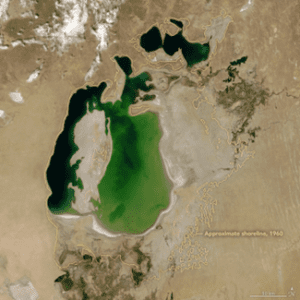TAG: GS 1: WORLD GEOGRAPHY
THE CONTEXT: The Aral Sea, an endorheic lake located between Kazakhstan in the north and Uzbekistan in the south, has nearly disappeared.
EXPLANATION:
- The Aral Sea, once a thriving endorheic lake situated between Kazakhstan and Uzbekistan, began its tragic journey towards near extinction in the early 1960s.
- The Soviet Union initiated a colossal water diversion project in 1960, redirecting the vital Syr Darya and Amu Darya rivers to foster agricultural development in the surrounding desert region.
- This ambitious endeavor aimed to transform the arid landscape but, unbeknownst at the time, set in motion a catastrophic sequence of events leading to the steady demise of the Aral Sea.

An image of the shrinking Aral Sea by NASA
Human Engineering and Agricultural Projects Gone Awry
- The Soviet water diversion project, while successful in making the desert bloom, inadvertently sowed the seeds of destruction for the Aral Sea.
- By diverting the lifeblood of the lake for irrigation purposes, the water body, once renowned for its abundance of fish and pristine blue waters, began a relentless decline.
- Today, the Aral Sea is a mere fraction of its former size, symbolizing the unintended consequences of large-scale human engineering and agricultural projects.
The Aral Sea Crisis: A Modern Environmental Catastrophe
- Climate Change Exacerbating the Desolation
- In recent times, the plight of the Aral Sea has been further aggravated by the impacts of climate change.
- Rising temperatures, altered precipitation patterns, and increased evaporation are compounding the challenges faced by this already beleaguered water body.
- Experts predict that climate change will accelerate the disappearance of the Aral Sea, intensifying the suffering of the communities residing in its vicinity.
- UN’s Stark Assessment
- The United Nations Development Program has labeled the destruction of the Aral Sea as “the most staggering disaster of the 20th century.”
- The repercussions of this environmental catastrophe are far-reaching, manifesting as land degradation, desertification, drinking water shortages, malnutrition, and deteriorating health conditions in the surrounding areas.
- The far-reaching consequences underscore the urgency of addressing this crisis comprehensively.
International Efforts and Ongoing Struggle
- Attempts at Restoration
- International aid organizations, national governments, and local groups have rallied together in an attempt to mitigate the damage inflicted upon the Aral Sea.
- Various restoration initiatives have been undertaken, ranging from water management projects to community-led efforts.
- However, despite these endeavors, the relentless pace of climate change threatens to outpace these mitigation measures, making the restoration of the Aral Sea an uphill battle.
- Impact on Local Communities
- The suffering of the residents around the Aral Sea is a poignant aspect of this crisis.
- Drinking water shortages, agricultural challenges, and health issues have become pervasive, eroding the livelihoods and well-being of those dependent on the lake.
- The precarious balance between human needs and environmental sustainability is at the forefront of the struggle to save the Aral Sea.
Conclusion: A Race Against Time
- The tragic decline of the Aral Sea stands as a stark reminder of the interconnectedness of human activities and environmental well-being.
- While efforts persist to reverse the damage wrought by human engineering and agricultural mismanagement, the accelerating impact of climate change poses an ominous threat.
- The plight of the Aral Sea serves as a clarion call for global collaboration, emphasizing the need for sustainable practices and climate resilience to prevent the irreversible loss of vital ecosystems.
- Time is of the essence as the Aral Sea races against the forces that conspire to erase it from the map.

